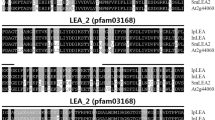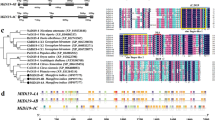Abstract
Plant growth and productivity are adversely affected by various abiotic and biotic stress factors. Despite the wealth of information on abiotic stress and stress tolerance in plants, many aspects still remain unclear. Prosopis juliflora is a hardy plant reported to be tolerant to drought, salinity, extremes of soil pH, and heavy metal stress. In this paper, we report the isolation and characterization of the complementary DNA clone for an atypical late embryogenesis abundant (LEA) protein (Pj LEA3) and its putative promoter sequence from P. juliflora. Unlike typical LEA proteins, rich in glycine, Pj LEA3 has alanine as the most abundant amino acid followed by serine and shows an average negative hydropathy. Pj LEA3 is significantly different from other LEA proteins in the NCBI database and shows high similarity to indole-3 acetic-acid-induced protein ARG2 from Vigna radiata. Northern analysis for Pj LEA3 in P. juliflora leaves under 90 mM H2O2 stress revealed up-regulation of transcript at 24 and 48 h. A 1.5-kb fragment upstream the 5′ UTR of this gene (putative promoter) was isolated and analyzed in silico. The possible reasons for changes in gene expression during stress in relation to the host plant’s stress tolerance mechanisms are discussed.





Similar content being viewed by others
References
Boyer, J. S. (1982). Science, 218, 443–448. doi:10.1126/science.218.4571.443.
Bray, E. A., Bailey-Serres, J., & Weretilnyk, E. (2000). In W. Gruissem, B. Buchannan, & R. Jones (Eds.), Responses to abiotic stresses pp. 1158–1249. Rockville, MD: American Society of Plant Physiologists.
Burkart, A., & Simpson, B. B. (1977). In B. B. Simpson (Eds.), Mesquite: Its biology in two desert ecosystems pp. 201–215. Stroudsburg, Pennsylvania, USA: Dowden, Hutchinson and Ross.
Drake, H. (1993). Trees for dry lands p. 370. New York: International Scientific Publishing.
Geilfus, F. (1994). In Enda-Caribe-Centro Agronómico Tropical de Investigación y Enseñanza (vol. 2, p. 597).
Shirke, P. A., & Pathre, U. V. (2004). Journal of Experimental Botany, 55(405), 2111–2120. doi:10.1093/jxb/erh229.
Sinha, S., Rai, U. N., Bhatt, K., Pandey, K., & Gupta, A. K. (2005). Environmental Monitoring and Assessment, 102, 447–457. doi:10.1007/s10661-005-6397-4.
SenthilKumar, P., Prince, W. S., Sivakumar, S., & Subbhuraam, C. V. (2005). Chemosphere, 60(10), 1493–1496. doi:10.1016/j.chemosphere.2005.02.022.
Dure, L., Greenway, S. C., & Galau, G. A. (1981). Biochemistry, 20, 4162–4168. doi:10.1021/bi00517a033.
Grzelczak, Z. F., Sattolo, M. H., Hanley-Bowdoin, L. K., Kennedy, T. D., & Lane, B. G. (1982). Canadian Journal of Biochemistry, 60, 389–397.
Galau, G. A., Hughes, D. W., & Dure, L. (1986). Plant Molecular Biology, 7, 155–170.
Bray, E. A. (1993). Plant Physiology, 103, 1035.
Cumming, A. C. (1999). In P. R. Shewry, & R. Casey (Eds.), Seed proteins (pp. 753–780). Dordrecht: Kluwer
Roberts, J. K., DeSimone, N. A., Lingle, W. L., & Dure, L. (1993). The Plant Cell, 5, 769–780.
Hughes, D. W., & Galau, G. A. (1989). Genes & Development, 3, 358–369. doi:10.1101/gad.3.3.358.
Welin, V., Olson, A., Nylander, M., & Palva, E. T. (1994). Plant Molecular Biology, 26, 131–144. doi:10.1007/BF00039526.
Ingram, J., & Bartels, D. (1996). Annual Review of Plant Biology, 47, 377–403. doi:10.1146/annurev.arplant.47.1.377.
Wise, M. J. (2003). BMC Bioinformatics, 4, 52 1040.
George, S., Venkataraman, G., & Parida, A. (2007). Genome, 50(5), 470–478. doi:10.1139/G07-014.
Emanuelsson, O., Nielsen, H., Brunak, S., & von Heijne, G. (2000). Journal of Molecular Biology, 300, 1005–1016. doi:10.1006/jmbi.2000.3903.
Nielsen, H., Engelbrecht, J., Brunak, S., & von Heijne, G. (1997). Protein Engineering, 10, 1–6. doi:10.1093/protein/10.1.1.
Gasteiger, E., Hoogland, C., Gattiker, A., Duvaud, S., Wilkins, M. R., Appel, R. D., et al. (2005); In J. M. Walker (Ed.), The proteomics protocols handbook (pp. 571–607). New York: Humana.
Tusnády, G. E., & Simon, I. (1998). Journal of Molecular Biology, 283, 489–506. doi:10.1006/jmbi.1998.2107.
Tusnády, G. E., & Simon, I. (2001). Bioinformatics (Oxford, England), 17, 849–850. doi:10.1093/bioinformatics/17.9.849.
Bauer, M. A., Anderson, J. B., Derbyshire, M. K., DeWeese-Scott, C., Gonzales, N. R., & Gwadz, M. (2007). Nucleic Acids Research, 35, 237–240. doi:10.1093/nar/gkl951.
Chomczynski, P., & Sacchi, N. (1987). Analytical Biochemistry, 162, 156–159. doi:10.1016/0003-2697(87)90021-2.
Mehta, P. A., Sivaprakash, K., Parani, M., Venkataraman, G., & Parida, A. K. (2005). Theoretical and Applied Genetics, 110, 416–424. doi:10.1007/s00122-004-1801-y.
Liu, Y. G., Mitsukawa, N., Oosumi, T., & Whittier, R. F. (1995). The Plant Journal, 8, 457–463. doi:10.1046/j.1365-313X.1995.08030457.x.
Higo, K., Ugawa, Y., Iwamoto, M., & Korenaga, T. (1999). Nucleic Acids Research, 27, 97–300. doi:10.1093/nar/27.1.297.
Murashige, T., & Skoog, F. (1962). Physiologia Plantarum, 15, 473–497. doi:10.1111/j.1399-3054.1962.tb08052.x.
Jefferson, R. A. (1987). Plant Molecular Biology Reporter, 5, 387–405. doi:10.1007/BF02667740.
Galau, G. A., Wang, H. Y.-C., & Hughes, D. W. (1993). Plant Physiology, 101, 695–696. doi:10.1104/pp.101.2.695.
Hundertmark, M., & Hincha, D. K. (2008). BMC Genomics, 9, 118. doi:10.1186/1471-2164-9-118.
Kyte, J., & Doolittle, R. (1982). Journal of Molecular Biology, 157, 105–132. doi:10.1016/0022-2836(82)90515-0.
Zegzouti, H., Jones, B., Marty, C., Lelievre, J. M., Latche, A., & Pech, J. C. (1997). Plant Molecular Biology, 35(6), 847–854. doi:10.1023/A:1005860302313.
Simpson, S. D., Nakashima, K., Narusaka, Y., Seki, M., Shinozaki, K., & Yamaguchi-Shinozaki, K. (2003). Plant Journal, 33, 259–270. doi:10.1046/j.1365-313X.2003.01624.x.
Marcotte, W. R., Russell, S. H., & Quatrano, R. S. (1989). The Plant Cell, 1, 969–976.
Kaplan, B., Davydov, O., Knight, H., Galon, Y., Knight, M. R., & Fluhr, R. (2006). The Plant Cell, 18, 2733–2748. doi:10.1105/tpc.106.042713.
Xue, G. P. (2002). Nucleic Acids Research, 30, e77. doi:10.1093/nar/gnf076.
Itzhaki, H., Maxson, J. M., & Woodson, W. R. (1994). Proceedings of the National Academy of Sciences of the United States of America, 91, 8925–8929. doi:10.1073/pnas.91.19.8925.
Brown, R. L., Kazan, K., McGrath, K. C., Maclean, D. J., & Manners, J. M. (2003). Plant Physiology, 132, 1020–1032. doi:10.1104/pp.102.017814.
Baker, S. S., Wilhelm, K. S., & Thomashow, M. F. (1994). Plant Molecular Biology, 24, 701–713. doi:10.1007/BF00029852.
Abe, H., Urao, T., Ito, T., Seki, M., Shinozaki, K., & Yamaguchi-Shinozaki, K. (2003). The Plant Cell, 15, 63–78. doi:10.1105/tpc.006130.
Hartmann, U., Sagasser, M., Mehrtens, F., Stracke, R., & Weisshaar, B. (2005). Plant Molecular Biology, 57, 155–171. doi:10.1007/s11103-004-6910-0.
Gowik, U., Burscheidt, J., Akyildiz, M., Schlue, U., Koczor, M., & Streubel, M. (2004). The Plant Cell, 16, 1077–1090. doi:10.1105/tpc.019729.
Stougaard, J., Jorgensen, J. E., Christensen, T., Kuhle, A., & Marcker, K. A. (1990). Molecular & General Genetics, 220, 353–360. doi:10.1007/BF00391738.
Bate, N., & Twell, D. (1998). Plant Molecular Biology, 37, 859–869. doi:10.1023/A:1006095023050.
Elmayan, T., & Tepfer, M. (1995). Transgenic Research, 4, 388–396. doi:10.1007/BF01973757.
Yanagisawa, S. (2000). The Plant Journal, 21, 281–288. doi:10.1046/j.1365-313x.2000.00685.x.
Zhou, D. X. (1999). Trends in Plant Science, 4, 210–214. doi:10.1016/S1360-1385(99)01418-1.
Piechulla, B., Merforth, N., & Rudolph, B. (1998). Plant Molecular Biology, 38, 655–662. doi:10.1023/A:1006094015513.
Kim, S. Y., Chung, H. J., & Thomas, T. L. (1997). The Plant Journal, 11, 1237–1251. doi:10.1046/j.1365-313X.1997.11061237.x.
Battaglia, M., Olvera-Carrillo, Y., Garciarrubio, A., Campos, F., & Covarrubias, A. A. (2008). Plant Physiology, 148, 6–24. doi:10.1104/pp.108.120725.
Baker, J., Steele, C., & Dure, L. (1988). Plant Molecular Biology, 11, 277–291. doi:10.1007/BF00027385.
Cuming, A. C. (1999). LEA proteins. In R. Casey & P. R. Shewry (Eds.), Seed proteins (pp. 753–780). Dordrecht, The Netherlands: Kluwer.
Kim, H. S., Lee, J. H., Kim, J. J., Kim, C. H., Jun, S. S., & Hong, Y. N. (2005). Gene, 3(344), 115–123. doi:10.1016/j.gene.2004.09.012.
Goyal, K., Walton, L. J., & Tunnacliffe (2005). Biochemical Journal, 388, 151–157, (15).
Acknowledgment
This work was carried out with a grant from Department of Biotechnology (DBT), Government of India. Ms. Suja George is a Senior Research Fellow of the Council of Scientific and Industrial Research (CSIR), India.
Author information
Authors and Affiliations
Corresponding author
Rights and permissions
About this article
Cite this article
George, S., Usha, B. & Parida, A. Isolation and Characterization of an Atypical LEA Protein Coding cDNA and its Promoter from Drought-Tolerant Plant Prosopis juliflora . Appl Biochem Biotechnol 157, 244–253 (2009). https://doi.org/10.1007/s12010-008-8398-6
Received:
Accepted:
Published:
Issue Date:
DOI: https://doi.org/10.1007/s12010-008-8398-6




